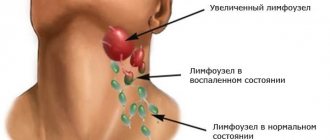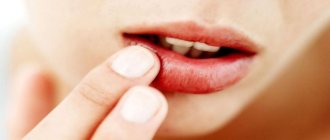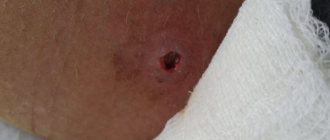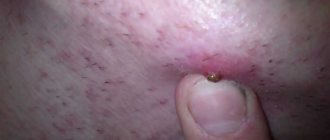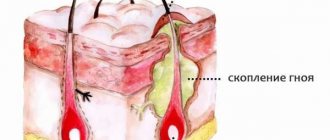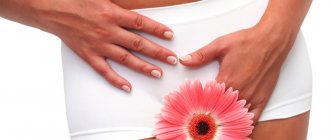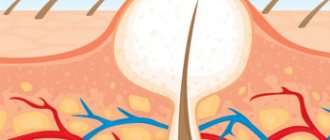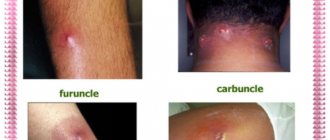Causes and symptoms
A furuncle or boil, whatever you call it, appears due to inflammation of the hair follicles. It is a mistake to believe that a boil differs from a boil in the scale of the inflammatory process - these concepts characterize one disease, regardless of:
- nature of the course;
- complexity of inflammation;
- the extent of damage to the skin area.
The cause of the disease is bacteria that cause purulent infections - often staphylococcus, streptococcus. The presence of bacteria in the body, against the background of some contributing factors, provokes inflammatory processes in the hair follicles. Among these factors are:
- disruption of the sebaceous glands - failures in the production of sebum, an increase in secretion volumes, changes in the structure, density, and chemical composition of the secretion;
- hormonal disorders - releases of a significant amount of hormones, strong changes in hormonal levels;
Purulent formations may appear on areas of the skin that have hair. The areas of constant friction that are most susceptible to inflammatory processes are the armpits, groin, buttocks, neck, as well as the face as the carrier of the largest number of sebaceous glands.
Why is there a problem?
The appearance of furunculosis is additionally promoted by:
- foci of infection in the body;
- diabetes;
- immune failure;
- hypovitaminosis;
- poor nutrition;
- chronic intoxication;
- skin injuries;
- failure to comply with basic rules of personal hygiene;
- local or general hypothermia.
Boils or boils are formed during purulent-necrotic inflammation of the hair follicles along with the surrounding tissues. Sometimes the process affects deep-lying cells of the dermis.
This is how boils differ from acne and rosacea (read how to treat rosacea separately). Due to inflammation of the surrounding tissue, microbes enter the bloodstream and then spread throughout the body, causing purulent inflammatory processes in the tissues.
If the disease is not limited to a single boil, but new formations appear, then they talk about furunculosis.
The causative agent of furunculosis is Staphylococcus aureus.
Also read the article “Mollus contagiosum - treatment at home”, it can also be confused with boils.
Stages of development
Medical science suggests distinguishing several stages of the formation, ripening and healing of a boil:
- Infiltration. A hyperemic edematous infiltrate forms, accompanied by redness, tension and soreness of the affected area. There may be symptoms of intoxication - headache, aching joints.
- Suppuration. A purulent-necrotic core is formed, accompanied by elevated temperature and severe pain.
If neighboring areas of the skin are involved in the inflammatory process, then such a formation is called a carbuncle - Aging. Spontaneous or surgical opening of a purulent formation occurs, accompanied by the release of purulent masses. The process is accompanied by an improvement in well-being and a decrease in pain.
- Scar formation. After removing the purulent mass (rod), a recess is observed in the soft tissues - a channel that previously contained a purulent rod. It is gradually filled with granulation tissue - scarring occurs.
The disease can progress in different ways, accompanied by a combination of certain stages, their accelerated or longer course - it all depends on the clinical condition of the patient and the presence of contributing factors.
Treatment
It is necessary to treat chiria and boils, since they are one disease, using the same methods, but preferably without self-medication. Medical consultation is necessary, even when you are confident that you know how to treat and how to treat chiria. The purulent formations themselves may not be as dangerous as their consequences caused by the lack of qualified medical therapy.
So, to the question: “how to treat chiria?” The attending physician must answer. Medical treatment depends on the nature of the disease, the clinical condition of the patient and the presence of aggravating factors.
Boils are treated mainly on an outpatient basis, if there are no contraindications, complications or complex lesions of the facial area. Therapy consists of several procedures:
- disinfection and pain relief;
- antibiotic and anti-inflammatory drug therapy;
- opening of the purulent core, drainage of purulent masses;
- the use of physiotherapy;
- vitamin therapy.
Skin problems are common among surgical and dermatological diseases. Most patients resort to self-medication, which is justified only in the early period of the pathology, but even in this case the possibility of complications cannot be ruled out. A surgically opened boil, carbuncle or abscess should be treated under the supervision of a physician to avoid the addition of various infections.
Differences between a boil and other skin growths
You can distinguish a boil from a pimple by visual inspection and palpation.
A furuncle is an inflamed area of skin that appears around the sebaceous gland of the hair. The causative agent of the infection is Staphylococcus aureus.
The type of chiria looks like a dot, with redness around it. On palpation, pain and warmth are felt.
For pimples and styes on the eye
It is easy to distinguish an inflamed boil from a pimple by palpation. Wear sterile gloves and touch the formation. Difference: if touching causes pain, there is redness around the lesion - a boil is determined.
A pimple occurs during the initial stage of inflammation of the skin. A pimple and a chiryak are similar. The furuncle is distinguished by the size and depth of the lesion.
The difference between a pimple and a boil:
| Acne | Furuncle |
| there is no pain on palpation; | pain inside the skin; |
| the lesion around is not bright red; | inflammation is characterized by redness; |
| the pimple is smaller in size; | 2-3 times larger in size; |
| location closer to the surface layer of the skin; | location deep in the skin; |
| ripens faster; | slow process of coming out; |
| no swelling around; | at the initial stage it is accompanied by swelling; |
| lack of temperature; | there is chills; |
| treatment 3-5 days; | therapy 7-14 days; |
| helps eliminate aloe leaf, kalanchoe | helps to cure “Vishnevsky Ointment”, “Levomekol”. |
Barley is accompanied by inflammation and suppuration of the hair follicle of the eyelid. The development of the disease is provoked by weak immunity, caused by a staphylococcal infection.
Symptoms:
- desire to scratch the eye;
- pain when blinking;
- redness of the eyelid;
- when the barley ripens, the pus comes out on its own after 3-5 days;
- drowsiness, loss of strength, temperature 37C;
- after the abscess ruptures, the patient feels relief.
The difference is that sometimes barley ripens without the presence of pus on its own. Treatment is based on rinsing with chamomile infusion or strong warm tea using a cotton swab.
Eye drops: “Levomycetin”, “Tobrodex”, “Tsiprolet”. “Hydrocortisone ointment” is used for primary redness of the eyelid.
From chancre
A chancre differs from a boil in that it resembles an ulcer with compacted edges located on the skin or mucous membrane.
The occurrence of ulcers occurs more often in the mouth or on the genitals.
Kinds:
- Extragenital chancrees are most often formed in the oral cavity, chest and anus. 75% of the damage occurs in areas of the head, arms, and neck.
- Genital chancre occurs in 95% of situations and affects the penis, vagina, and labia. Sometimes the cervix is affected.
Symptoms:
- round form;
- bright red tint with a surface film;
- chancre is not capable of inflaming nearby areas;
- upon palpation, a solid base is felt, there is no pain;
- after recovery, pigmentation remains in place, which goes away over time.
Chancres are distinguished from 1 to 4 cm.
For folliculitis
It is difficult to determine the difference between deep folliculitis and a boil until a purulent core forms. The composition is close to the composition of a boil. It happens that folliculitis develops into another form.
Clinical picture of folliculitis:
- the initial stage is characterized by the formation of an abscess at the mouth of the follicle;
- skin hyperemia increases to 5-7 mm;
- a papule is formed, the diameter of which is 5 mm, with a hair located in the center;
- after 2-3 days, a pustule forms, forming a crust;
- recovery is accompanied by redness and pigmentation.
Therapy for folliculitis is based on taking antibiotics: Ciprofloxacin, Fluconazole, Terbinafine. Taking medications depending on the type of tumor.
For hidradenitis
Sweat glands with hidradenitis fester. Locally, suppuration is located in:
- perineum;
- armpit areas;
- nipple halo;
- groin area.
The cause of development is staphylococcus, which flows through the lymph into the sweat glands. The formation can be provoked by a violation of fat metabolism and the functions of the sweat glands.
Signs:
- the size of the formations is about the size of a pea, takes on a pear shape;
- defects reach 30-40 mm;
- formation of a soft structure inside;
- pus from the fistula canal is determined;
- the central rod is missing;
- the lesion opens on its own, the pus comes out, forming a scar;
- often there is a combination of lesions with a large number of fistulas with bumpy skin;
- when it comes out there is a thick consistency of pus, a bloody mixture;
- treatment takes 14-21 days, sometimes up to 4 months;
- When some abscesses come out, new formations appear.
Symptoms:
- painful pear-shaped nodes;
- pain when touched;
- the skin near the abscess is red-blue;
- headache, weakness, fever develops;
- increased leukocyte count, ESR.
Hidradenitis is often confused with phlegmon, abscess, and lymphadenitis. The difference from boils and other neoplasms is that it develops deep in the tissues.
Treatment:
- Antibiotics: Erythromycin, Doxycycline.
- Antiseptics: “Ethyl alcohol”, “Iodine solution”.
- Blue lamp - warming up for up to 5 minutes.
- The mature formation is excised to healthy tissue.
When pus forms, UHF and SMV therapy are often prescribed. Opening is not recommended; the abscesses are at various stages of maturation.
From atheroma and wen
Furuncle and atheroma: atheroma is formed when the excretory system of the sebaceous glands is disrupted. It is filled inside with a composition similar to gruel with fat deposits from 5 mm to 5-7 cm. It is formed on the head, neck, and in the area between the shoulder blades.
Causes of atheromatosis:
- traumatization of the ingrown hair bulb, blocking the outflow of secretions;
- Gardner's syndrome;
- thickening of secretions;
- developmental defects;
- squeezing out formations, cutting an area.
Atheroma compresses the vessels and tissues around the formation.
When atheroma becomes inflamed, infection occurs, pus forms, and an abscess develops:
- pain;
- temperature;
- hyperemia of the skin;
- swelling;
- pus comes out spontaneously upon opening.
Causes:
- hormonal disbalance;
- Men are more susceptible due to the structural features of the sebaceous glands;
- presence of acne;
- microcracks in the skin;
- not maintaining personal hygiene;
- facial cosmetics, deodorants.
Treatment at the first stage of pathology without pus:
- Application of radio waves.
- Laser treatment.
- Elimination by surgery using a scalpel.
There are no side effects with radio wave therapy. Therapy lasts 5 days.
If pus is present, surgery with incisions and sutures is used.
A lump differs from a boil in that it goes away without pain, it is soft and mobile, and is not fused to neighboring tissues. They reach more than 10 cm in diameter, small ones are 1-5 cm, affect nerve endings, resulting in pain. The fatty tissue acts as a cosmetic defect; the formation with the capsule is removed to avoid new formations.
An effective method is suction. Using an electric suction, the contents of the wen are removed. The method does not require stitching and leaves no marks.
There are lipomas and benign tumors.
Peculiarities:
- soft consistency;
- no pain;
- moves easily;
- more often found in areas not rich in adipose tissue: back, thigh, shoulders.
The formation is not dangerous and does not develop into a cancerous tumor. When visiting a sauna under the influence of heat it resolves on its own. For large lesions, desquamation is required.
For bartholinitis
Bartholinitis is an inflammation of the gland of the labia majora of the vagina.
Causes of pathology:
- reduced immunity, freezing;
- Escherichia coli, Trichomonas;
- infection enters through the blood and ducts.
Symptoms:
- feeling of discomfort;
- redness;
- swelling of the labia;
- temperature from 37.5 to 40°C.
Therapy depends on the stage of the process:
- UV irradiation, UHF, magnetic therapy are prescribed;
- antibiotics: Metronidazole, Amoxicillin, Ofloxacin;
- compresses with “Ichthyol ointment”, “Vishnevsky ointment”;
If suppuration is present, the abscess is removed surgically.
What is a boil?
A furuncle is an acute inflammatory process affecting the hair follicle and nearby fatty tissue under the skin.
In children and adolescents, a boil is an indicator of many diseases.
The abscess has a round shape, slightly rising above the surface of the skin. The affected area (buttocks, thighs, armpits, face, neck, ear canal or nasal cavity) becomes red, swollen, and the person experiences pain when touched. As a result of the proliferation of pathogenic bacteria, a purulent pocket is formed. After 4-6 days, it becomes white (due to the approach of pus to the surface of the skin), and clear liquid oozes from it. In case of frequent relapses of the disease, a diagnosis of “chronic furunculosis” is made.
What is the difference between a boil and a carbuncle?
An accumulation of abscesses, which is accompanied by purulent-necrotic inflammation, is called a carbuncle. The formation is most often localized on the back, buttocks, and back of the head.
Carbuncle is a severe purulent disease in which a large purple-red lesion with numerous purulent cavities forms on the skin. The disease proceeds much more complex than a boil, forming a significant affected area. Pus accumulates not only in the center of the abscess: in this case, many cavities filled with exudate are formed. The difference between a boil and a carbuncle is that the first manifests itself locally, and the second affects the general condition of a person (symptoms of intoxication occur: muscle pain, a feeling of fatigue, fever, migraine).
Symptoms
Before a boil or boil ripens, a person goes through several stages, differing in symptoms. Development on the body begins with the appearance of a hard infiltrate on the skin, which is accompanied by redness of the skin, and pressing on the infiltrate causes pain.
As the infiltrate increases, the person experiences increased redness and pain when pressed, and swelling appears around the affected area.
The growth of a boil occurs in several stages, and at the end this formation bursts and pus comes out.
After 2-3 days, the boil looks like a cone, and a pustular core forms in the center, which ends on the surface of the skin with a small bubble of pus.
The size of the pimple reaches 3 centimeters. This stage of development is sometimes accompanied by fever up to 38 degrees and symptoms of intoxication.
Causes of appearance, development and symptoms
The most common “culprit” for the development of boils is Staphylococcus aureus. This pathogen exists on the skin of most people without causing harm to the body in an inactive state. Any scratch or cut can cause a boil: the immune system reacts to the injury and sends white blood cells to the affected area, which fight bacteria. As a result, dead microorganisms and immune cells begin to accumulate in one of the areas, which provokes the formation of pus. The main factors for the appearance of boils are:
- In boys, as they grow up, a hormonal imbalance occurs in the body, the skin becomes oilier, which encourages the development of bacteria;
- close contact with a person who has a boil;
- violation of personal hygiene rules;
- active sports, as a result of which constant friction of the outer integument occurs and the activity of the sweat glands increases;
- unsanitary conditions;
- the presence of other skin diseases (dermatitis or scabies);
- excess weight.
A boil can develop in a completely healthy person. If the disease relapses, you should be examined in a hospital for hepatitis, diabetes and other diseases.
The clinical picture of boils is well differentiated from other dermatological pathologies. 2-3 days before the formation of an abscess, the patient notices itching, increased local temperature and twitching pain. Then an inflammatory infiltrate and painful cone-shaped abscesses appear.
Carbuncles, like boils, are caused by Staphylococcus aureus. Most often, the disease affects people with weakened immune systems. The following groups of people are at risk of getting sick:
- people with diabetes;
- HIV-infected;
- taking hormonal medications for a long time;
- undergoing chemotherapy;
- constantly hungry;
- having skin diseases localized over a large area of the body;
- drug users;
- having heart disease.
The carbuncle has several distinctive features:
- on one of the areas of the outer cover there are several dense painful nodes, which subsequently merge together;
- Outwardly, the formation resembles a blue ball, its contents are blood and lymph.
Diagnosis of the disease
Diagnostic stages:
- You need to consult a dermatologist, surgeon, immunologist and endocrinologist. Doctors will collect a history of the disease, examine the area of skin where chiria most often appear, and make a differential diagnosis of the disease from others.
- Complete blood count - increased ESR and leukocytes.
- General urine analysis.
- Dermatoscopy of the affected area.
- Bacterial culture of the boil will determine the pathogen.
- Immunological research.
- Blood sugar test.
To make a more accurate diagnosis, dermatoscopy is prescribed.
Diagnosis of a boil does not cause any particular difficulties, since the clinical picture of the disease is very characteristic. It is necessary to distinguish boils from skin lesions caused by anthrax, hidradenitis, and deep trichophytosis.
To make a diagnosis, dermatoscopy (examination under high magnification) of the affected area may be prescribed. To determine the causative agent, it is recommended to culture the purulent boil. At the same time, the sensitivity of microflora to antibiotics is determined.
Important! If boils form frequently and are multiple, a general examination of the patient is necessary to determine the cause of the disease.
The difference between boils and carbuncles from hidradenitis, skin abscess and cellulitis
Correct differential diagnosis of purulent diseases contributes to the prescription of the correct treatment regimen.
Visible swelling, hyperemia over the abscess and fluctuation of the tissues above it are not observed if the abscess occurs in the thickness of the tissues or inside the organs.
- Differences from an abscess. An abscess is an inflammatory process with the accumulation of exudate in a limited area, accompanied by cell death and purulent melting (destruction) of tissue. A feature of the abscess is the formation of a pyogenic granuloma from young cells and overgrown capillaries, which surrounds the purulent focus and delimits it from healthy areas. Manifestations of an abscess coincide with symptoms of purulent inflammation of various kinds: headache, chills, nausea, fever, general weakness.
- Comparison with phlegmon. Phlegmon is a diffuse acute suppuration of various types of tissue (subcutaneous, intermuscular, rectal, perinephric, retroperitoneal), actively spreading to tissues, muscles, bones and tendons. The difference from a carbuncle is the blurred outline. The pyogenic membrane, as in an abscess, is absent.
- Difference with hidradenitis. Hidradenitis is an acute suppuration of the sweat glands located in the groin, perineum, armpit cavities, and peripapillary area. Pathogens penetrate through the lymphatic vessels or through skin wounds and erosions into the ducts of the sweat glands and actively multiply, which is provoked by copious sweat secretion and its alkaline environment.
An abscess with hidradenitis ruptures on its own, releasing thick pus from the fistula canal, in place of which, after healing, a scar is formed. When ruptured, the purulent masses are thick, sometimes mixed with blood.
Several abscesses can unite, forming a dense formation with an uneven surface and many fistulas. Confluent abscesses with hidradenitis are similar to phlegmon, but unlike it, the skin over the purulent contents is lumpy.
Stages of furunculosis
Furunculosis occurs in several stages.
- Stage 1 – infiltration. A red spot appears around the hair follicle. This indicates the presence of inflammatory edema deep in the dermis. It causes slight pain on palpation. Gradually, the area of inflammation begins to grow and becomes denser.
- Stage 2 – purulent. The symptoms and clinical picture of the disease are more clear. An inflammatory tumor-like formation appears on the surface of the skin, clearly visible, with quite serious pain. Your body temperature may even rise. Possible: loss of appetite, headaches, weakness, malaise. The bladder ruptures at this stage, and purulent discharge comes out along with the rod.
- Stage 3 – necrosis. Those tissues that surround the boil, the hair boil itself, the hair follicle and the sebaceous gland become necrotic. Death of small vessels occurs. Bloody discharge appears.
- Stage 4 – healing. The ulcer at the site of the boil heals within 3-4 days. The resulting scar fades over time and becomes completely invisible.
Treatment
A dermatologist will help diagnose boils and carbuncles. Carrying out health measures at home is allowed only if the development of a boil is mild. Moderate and severe forms of pathology require professional therapy or, in the presence of complications, surgical intervention.
Conservative treatment of furunculosis is complex and includes the use of analgesics, antibacterial drugs and medications for external use.
Painkillers
During the process of maturation, carbuncles and boils provoke pain. To relieve throbbing pain, doctors prescribe analgesic drugs that help relieve inflammation:
- "Paracetamol". The medicine should be taken 1 tablet at a dosage of 500 mg four times a day.
- "Ketonal". Take the medication three times a day, 1 capsule (50 g).
- "Nise." Method of treatment: 1 tablet (100 mg of active substance) is taken twice a day after meals.
The first 2 drugs on the list also have an antipyretic effect, and the last one has an anti-edematous effect.
Antibiotics
Antibacterial agents are prescribed individually for complications or in case of localization of a carbuncle or boil on the head. Let's look at the most effective medications in this group:
- "Doxycycline." Broad-spectrum antibiotic of the tetracycline series, active against streptococci and staphylococci. When treating the dermatological ailments under consideration, it eliminates staphylococcus bacteria, as a result of which the abscess (boil, carbuncle) passes through all stages of development more quickly, and its core is rejected.
- "Ampicillin." Kills the same pathogens as the previous medication, but is a penicillin antibiotic. Effectively fights bacteria, accelerates the process of carbuncle or boil maturation and wound healing.
- "Cefotaxime". Refers to antibacterial agents of the cephalosporin series. Destroys gram-positive and gram-negative bacteria, accelerates the process of suppuration and breakthrough. Promotes rapid healing of wounds.
Ichthyol ointment
Treatment of chiria in most cases is carried out using external means. The drug must be selected by a doctor.
It is impossible to say for sure which ointment for chiria is better, since in each specific case different drugs can help. At the initial stage, disinfectants or those that draw out pus are used.
This is Vishnevsky ointment, ichthyol, heparin or syntomycin.
Everyone used to know what this drug helps with, and it was in every home medicine cabinet. Vishnevsky ointment is effective both at the initial stage of boil maturation and after removal of pus.
This drug has the following properties:
This is an inexpensive sulfur-based drug. The ointment looks like a thick, almost black tar-like mass with an unpleasant odor, so not everyone likes it.
But ichthyol ointment for chiria is very effective. Reviews note that it helps at any stage of its maturation.
The ointment has anti-inflammatory and antiseptic effects. Destroys staphylococci, streptococci and other pathogenic microorganisms.
Ichthyol effectively relieves pain and stimulates tissue regeneration processes.
If you choose Levomekol for the treatment of boils, then you need to treat the wound with an antiseptic and apply a sponge with ointment to the surface. Place a sterile bandage on top and secure it with a bandage. The ointment must be used for 4 days, changing the bandage every few hours.
Vishnevsky ointment perfectly helps remove pus from the wound. It is necessary to apply the ointment under the bandage 4 times a day.
Hypothermia must be avoided. It is necessary to start applying ointment at the beginning of the formation of a boil and continue to do this even after the boil has broken through.
This will help avoid recurrence of inflammation.
Use ointments for boils
Ichthyol ointment is the most effective remedy for the formation of a boil. On the first day of the formation of a boil, ichthyol ointment should be immediately applied to the wound.
On average, up to 5 days of treatment are required. Apply a little ointment to the swab and attach it to the wound with an antiseptic patch overnight.
In the morning, wash off the ointment and repeat the procedure, changing the bandage every 3 hours during the day.
Traditional methods
Alternative medicine accelerates the process of maturation of a carbuncle or boil and helps relieve pain.
Recipes from traditional healers are allowed to be used in mild stages of dermatological disease and only under the supervision of the attending physician.
Baked onion
The recipe makes the carbuncle ripening process faster and also produces an antibacterial effect.
The oven should be preheated to 180°C. Place the onion, cut in half, on a baking sheet, cut side down, and leave for 5 minutes. The slightly cooled baked vegetable must be applied to the carbuncle or boil, secured with a band-aid, and wrapped in a warm cloth or scarf. Keep it on for 2 hours, then change the bandage. The procedure must be carried out 6 times a day until the boil breaks through.
Rye flour with honey
To prepare, you will need 100 g of honey, laundry soap (72%) and rye flour. The soap must be grated and melted in a water bath, then mixed with honey, gradually add flour until the consistency of an elastic cake. Apply the resulting dough to the boil (carbuncle), wrap it in cling film or polyethylene and leave overnight. The procedure is carried out until the boil breaks and pus comes out.
Indoor ficus
One leaf of the plant must be twisted through a meat grinder, and the second one must be immersed in boiling water until softened. Place the pulp obtained from the first leaf on the second, apply to the carbuncle, fix and leave overnight. The manipulation must be repeated until the pus comes out.
Folk remedies for boils and boils
Such drugs are often used in the treatment of boils. Antibacterial ointment for chiria is used if it has jumped up on the face, if there are a lot of boils, and also if the person has a weakened immune system. There are several of the most popular and effective antibiotic-based drugs.
- "Levomekol" is probably the best ointment for chiria. It has a stretching, anti-inflammatory, antibacterial and healing effect. Therefore, it can be used at any stage of the disease. In addition to destroying bacteria, Levomekol restores tissue by improving metabolic processes. The medicine is administered under a sterile bandage, which must be changed daily.
- Tetracycline ointment is more affordable. It is effective against chiria, as it is based on an antibiotic that is active specifically against staphylococci. This ointment can be applied in a thin layer to an immature boil 2-3 times a day. And after removing the pus, you should use it under a bandage.
- "Oflokain" contains lidocaine in addition to the antibiotic, therefore it reduces pain and relieves swelling.
The following types of antibiotics are used to treat boils:
- Penicillins. A very useful drug specifically for the treatment of inflammatory processes on the skin, including boils. Treatment should be carried out: Ampicillin, Bicillin, Amoxicillin, Ampiox.
- Cephalosporins. This medication is used to prevent the spread of infection and inflammation of the skin. The use of Cefuroxime, Cephalexin, Cepiphim, Cefazolin is practiced.
- Macrolides. This drug is used if, against the background of the maturation of boils, the temperature rises and a febrile state appears. Treatment should be carried out: Azithromycin, Erythromycin, Sumamed, Macropen.
Antibiotics should be used for severe inflammation
Only a doctor can choose treatment and the right antibiotic, so it is strictly forbidden to carry out independent treatment without consulting a doctor.
Complications and consequences
Advanced furunculosis provokes the development of bacteremia and septicemia, as well as the spread of staphylococcal infection throughout the body. In the pathologies under consideration, heart valves, bones, large joints, and organs of the excretory system are affected.
A dangerous complication is meningitis, which occurs due to infection of the brain.
Complications also include the development of phlegmon. Other adverse consequences are also possible: impetigo (multiple ulcers on the skin); septic arthritis (inflammation and subsequent destruction of joints caused by infection).
Factors of occurrence
The causative agent of the infection is usually a pyogenic bacterium - Staphylococcus aureus. This bacterium is present on the skin of any healthy person, and causes infection only if it reaches the deep layer of the skin (for example, through microtrauma). The development of boils is also promoted by:
- dirty skin;
- increased sweating;
- overweight;
- poor nutrition;
- hot humid climate;
- hormonal imbalances in the body;
- poor metabolism.
People with diabetes mellitus, skin diseases, and those prone to stress and depression are often at risk of developing furunculosis because they have a weakened immune system.
Stages of development
At the very beginning of development, a boil can easily be confused with an ordinary pimple. However, within 3-4 days the inflammation grows, covering the surrounding tissues. Upon palpation, you can feel the tension and density of these tissues.
After a few more days, a sac with a purulent formation forms in the center of the boil, a necrotic core appears and the tissue softens.
Over time, the boil, unable to withstand a large amount of pus, opens and the pus, rejecting the necrotic core, flows out. After which the swelling gradually subsides and redness passes, and a small scar forms in the center of the former boil.
The most dangerous boils are those that arise near the lips, ears and nose. You should not try to squeeze out boils yourself, even if they have arisen in other locations. This can lead to the spread of infection, which will entail serious complications leading to the development of regional lymphadenitis, lymphangitis, and thrombophlebitis.
What is the danger of this disease?
The main danger of this disease is the potential development of life-threatening complications. Thus, boils located in the area of the nasolabial triangle should be under close medical attention.
The blood supply in this area has such characteristics that infection through the blood vessels can easily penetrate into the area of the orbit and skull, causing the development of intracerebral and orbital complications. When boils are located near the lymph nodes, patients often experience lymphadenitis and lymphangitis.
Decreased immunity and illiterate treatment of the disease can lead to generalization of the infectious process and the development of sepsis (blood poisoning).
Treatment at home
If the immune system is functioning well, the boil will heal itself in 7-8 days. But to make the process go faster, you can treat boils at home:
at the initial stage of development, it is necessary to lubricate the abscess with a solution of fucorcin or brilliant green;
at the stage of compaction and swelling of the connective tissue, it is good to sunbathe in the sun;
To make the boil empty faster, you need to apply ichthyol ointment;
It is better to treat an opened abscess with hydrogen peroxide, and also apply bandages with sodium chloride or honey;
When the boil begins to heal, it is recommended to apply bandages using Vishnevsky ointment.
To prevent the development of purulent formations, you need to shower daily. Do not scratch the itchy area on the skin. Among other things, it is recommended to wear clothes made from natural fabric.
Prevention
The following recommendations are made as preventive measures:
- lead a healthy lifestyle;
- treat damaged skin areas with antiseptics (iodine, alcohol, hydrogen peroxide);
- maintain personal hygiene;
- avoid hypothermia.
By following simple rules and our recommendations, you can prevent or cure yourself and your family from furunculosis with minimal consequences in the early stages of the disease. Be healthy!
When to contact a surgeon
Boils can be treated at home only for those who are not at risk (do not suffer from chronic diseases), and boils are small in size (up to 5 mm). You should not self-medicate in the following cases:
if the appearance of a formation is accompanied by intense pain and fever;
if the abscess has not opened within 2 weeks;
if furunculosis has developed;
if the abscess occurs in a small child;
if the boil is near the nose, lips, in the ear canal;
there was a relapse of the disease.
Antibiotic treatment
In cases where the boil is large or located in sensitive areas, and its development is accompanied by intoxication, chills and severe inflammation, the surgeon prescribes antibiotics.
For a large boil and a slight increase in temperature, a weekly course is prescribed: the doctor prescribes clindamycin or doxycycline.
At high temperatures and severe inflammation, a two-week course of treatment is most often prescribed, which includes stronger antibiotic drugs: rifadin, rimactan or other analogues.
Don’t forget, Staphylococcus aureus easily adapts to a variety of antibacterial agents, and as soon as the body’s defenses are slightly reduced, they multiply and form new abscesses. Therefore, people with reduced immunity should immediately consult a doctor and not self-prescribe medications. Keep in mind that if you relapse, they will no longer help you!
We hope you found the information you needed in the article. Get well!
Therapeutic measures
Having found out what a boil is and familiarized itself with its possible types, a person begins to look for ways to treat the disease. Here it should immediately be noted that Staphylococcus aureus, which is the causative agent of the inflammatory process, is an extremely insidious microorganism. It does not die at a temperature of 100 o C, it cannot be destroyed with alcohol. In general, furunculosis is a much more complex disease than it might seem at first glance. Therefore, no matter what type of boil it is, it is better to go to the doctor immediately.
In this case, the question naturally arises, which doctor treats boils. This problem, in its general understanding, is dealt with by a dermatologist. It is he who will tell you which doctor to go to next with a boil, if you need to open it - in this case, you may also need the services of a surgeon. As such, various external agents are often used, for example:
Ichthyol ointment;- Vishnevsky ointment;
- Tetracycline ointment;
- Gentamicin ointment;
- Dimexide and others
It is important at the stage of necrosis to speed up the process of rod removal. Under no circumstances should you press on the abscess or puncture it. You can place a gauze bandage with salicylic acid on the surface of the abscess. When the boil breaks and the pus comes out, the area must be treated with an antiseptic.
Note! In the case where the abscesses are multiple, chronic, or of a more complex type, they are removed surgically.
This is especially true in cases where the formation is accompanied by an abscess. In this case, the surgeon opens the abscess, cleans its cavity and treats the surgical area with special means. Despite the fact that such treatment of boils is the least preferable for the patient, sometimes it is the only possible one.
In any case, before using one or another treatment method, it is necessary to consult a specialist. If complicated ulcers appear, do not attempt self-medication, relying on the advice of friends, but immediately go to the clinic, where the attending physician will not only make an accurate diagnosis, but also prescribe treatment, and also give recommendations regarding behavior taking into account the current circumstances.
Comments
- megan92 () 2 weeks ago
Has anyone managed to get rid of papillomas in their armpits? They really bother me, especially when you sweat.
- Daria () 2 weeks ago
I have already tried so many things and only after reading this article, I was able to get rid of papillomas in the armpits (and on a very budget). PS But I’m from the city myself and didn’t find it on sale here, so I ordered it online.
- megan92 () 13 days ago
Daria, post a link to the article! PS I'm from the city too))
- Daria () 12 days ago
megan92, that’s what I wrote in my first comment) I’ll duplicate it just in case - a link to the article.
- Sonya 10 days ago
Isn't this a scam? Why do they sell on the Internet?
- Yulek26 (Tver) 10 days ago
Sonya, what country do you live in? They sell it on the Internet because stores and pharmacies charge outrageous markups. In addition, payment is only after receipt, that is, they first looked, checked and only then paid. And now everything is sold on the Internet - from clothes to TVs and furniture.
- Editor's response 10 days ago
Sonya, hello. This drug for the treatment of papillomavirus infection is indeed not sold through pharmacy chains and retail stores in order to avoid inflated prices. As of today, you can only order on the official website. Be healthy!
- Sonya 10 days ago
I apologize, I didn’t notice the information about cash on delivery at first. Then everything is fine if payment is made upon receipt.
- Margo (Ulyanovsk) 8 days ago
Has anyone tried traditional methods to get rid of warts and papillomas?
- Andrey A week ago
I tried to burn off a wart on my head with vinegar. The wart really went away, only in its place there was such a burn that my finger hurt for another month. And the most annoying thing is that after a month and a half, two more warts popped up nearby ((
- Ekaterina A week ago
I tried to burn out the papilloma with celandine, but it didn’t help, it just turned black and became so scary (((
- Maria 5 days ago
I recently watched a program on Channel One, they also talked about this PAPIFEX. Many doctors recommended for treatment. I ordered it, I use it, and indeed, the papillomas are dissolving one by one, there are only 2 left, the most tenacious ones.
- Elena (dermatologist) 6 days ago
Maria, soon these two will disappear too!
- Alexandra (Syktyvkar) 5 days ago
A good product, completely worth the price. I have never seen any analogues.
- Maxim Today
Has anyone tried to reduce papillomas with liquid nitrogen?
- Tatyana (Ekaterinburg) Today
Yeah, you burn one, after a month three more grow ((I don’t recommend liquid nitrogen, although hospitals often use it
- Elena (dermatologist) 6 days ago
Tatyana, liquid nitrogen is a thing of the past, now PAPIFEX is used in full and there is no need to go to the doctors!
- Mikhail (Moscow) Today
PAPIFEX also helped (I ordered it according to the advice above), it should work, try it
- Vika (Ekaterinburg) Today
That's great! I need to order, otherwise I’m already tormented with these warts! After all, a woman always wants to be beautiful!
- Kristina (Minsk) Today
I had papillomas removed with a laser, quickly and without pain. But it's damn expensive.
